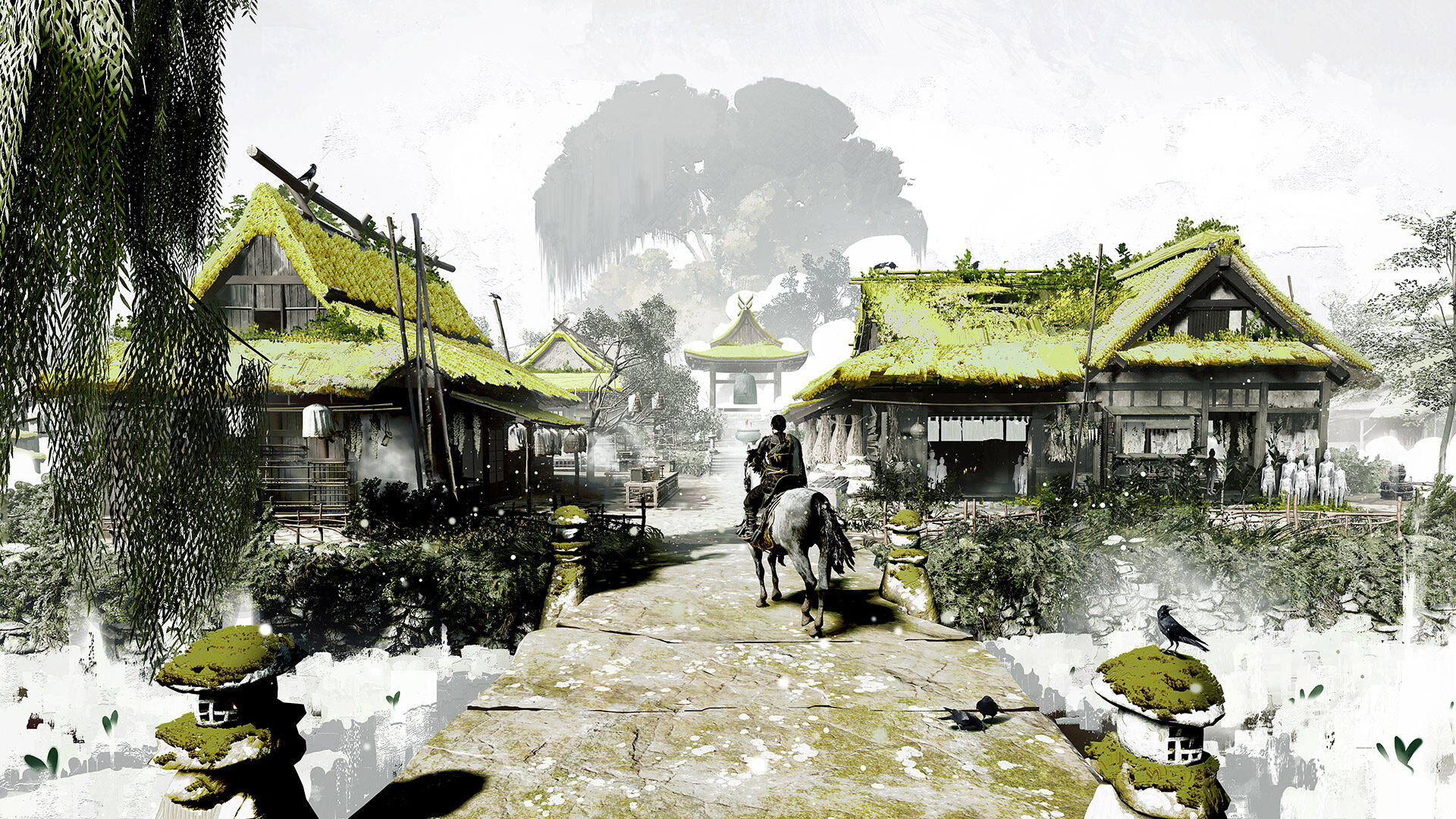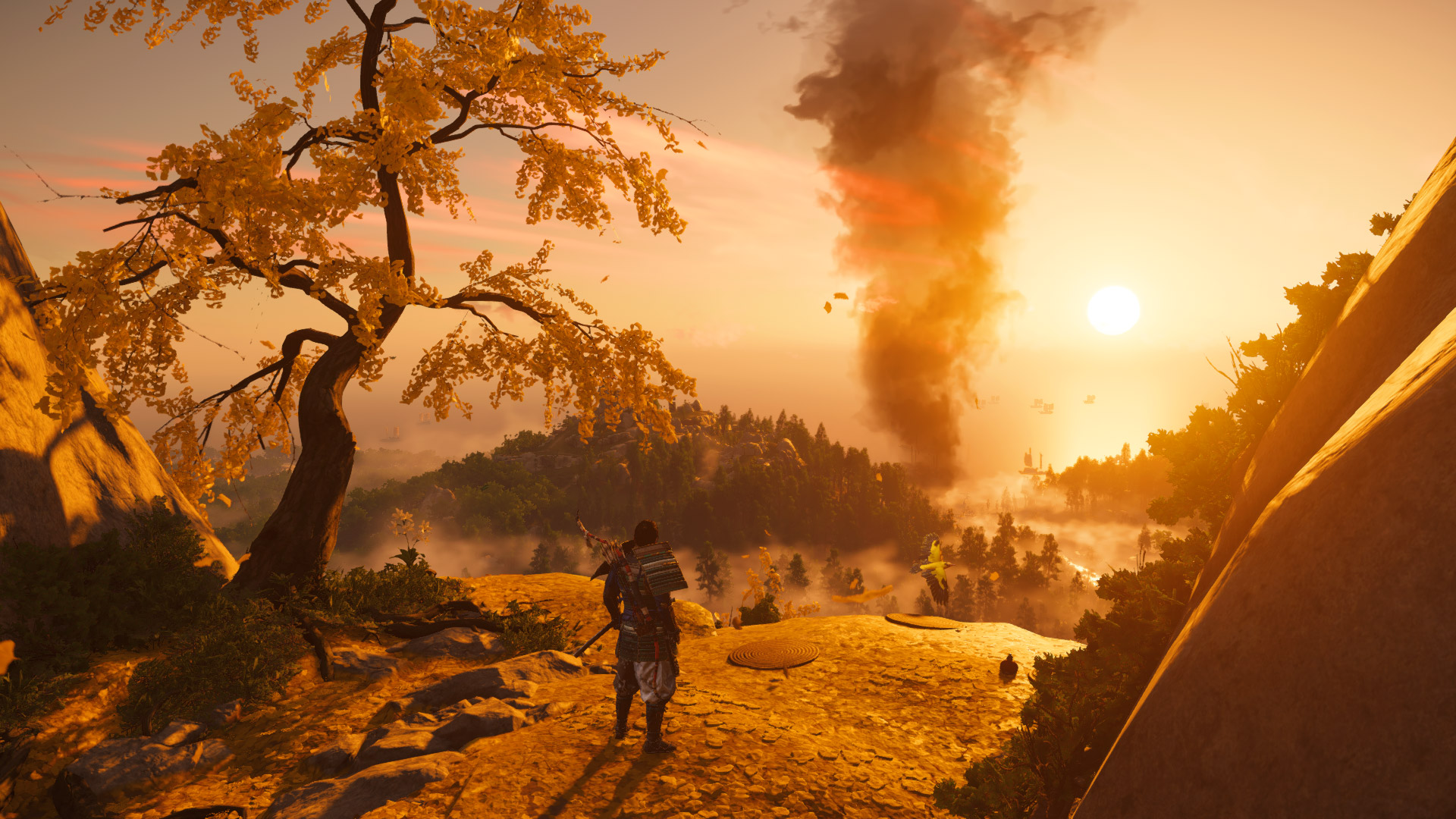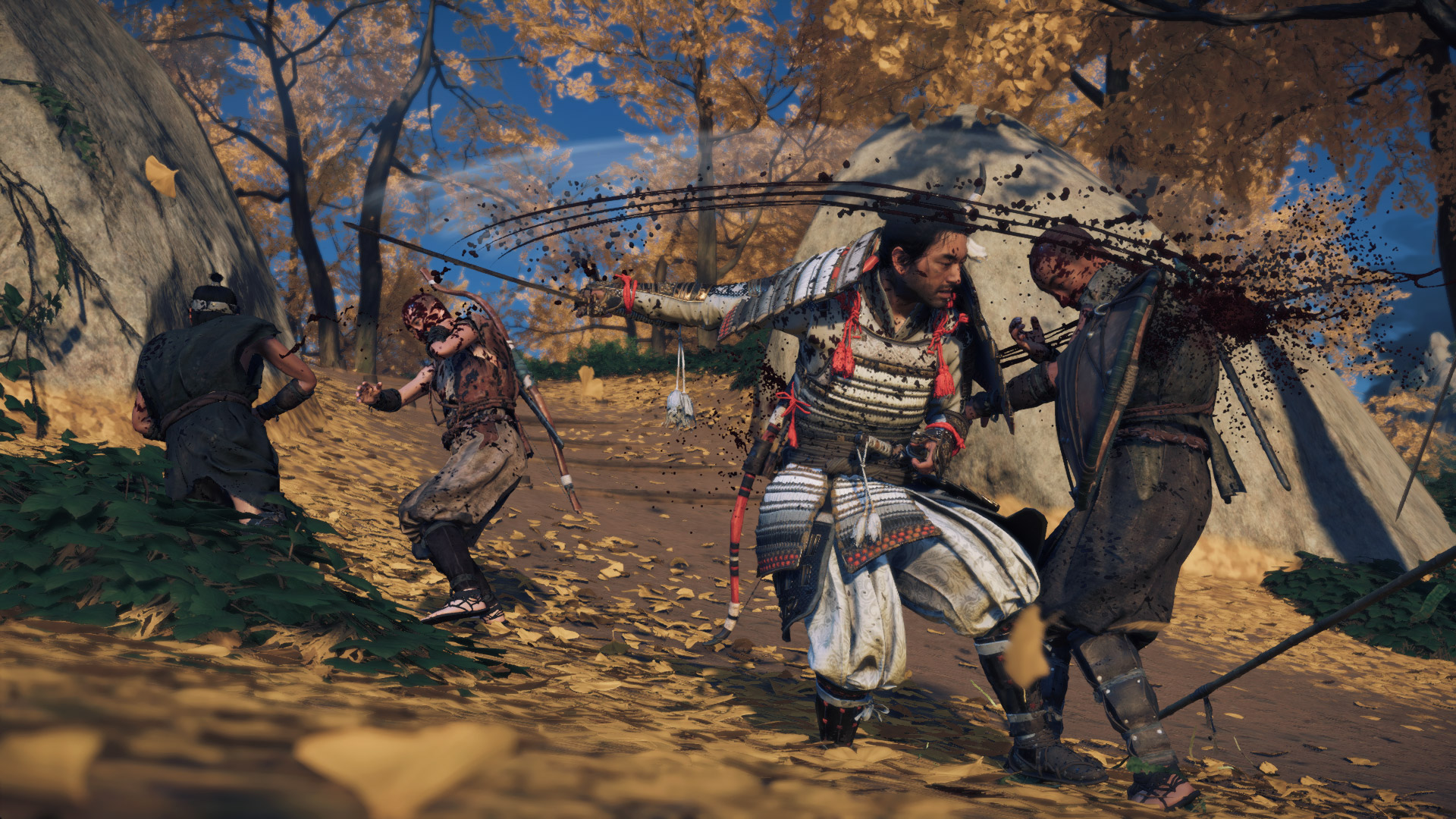Ghost of Tsushima Review
Ghost of Tsushima begins at a pivotal moment in Japanese history: the landing of Mongolian warriors on the shores of the island of Tsushima, the spark which would kick off the first Mongol invasion of Japan. For this fictional retelling of that real-life conflict, we step into the boots of Jin Sakai, a noble samurai, head of the Sakai clan, and nephew to the island’s jito, Lord Shimura. Jin joins his uncle as Tsushima’s forces ride to meet the enemy—but the Japanese army is almost entirely wiped out.
Saved by a woman named Yuna, Jin wakes up days later far from the battleground. Yuna’s actions aren’t entirely altruistic: The Mongols have taken her brother captive, and she knows the best chance to save him is by recruiting a samurai who’s already seen what the foreign warriors are capable of. Finding himself a wanted fugitive in a home now occupied by hostile forces, Jin sets off to both free Yuna’s brother and find help in rescuing Lord Shimura from the ruthless Mongol general, Khotun Khan. To do so, he’ll need to travel across the Tsushima countryside, discovering ways to become a stronger and more cunning warrior, liberating areas from the Mongol forces that hold them, and convincing would-be allies to join his cause.
Sucker Punch’s decision to make Ghost of Tsushima open world was one I wasn’t sure about at first, as I tend to think more linear games serve these types of stories better, due to their ability to keep focus on the main narrative. Well, turns out I was wrong this time, because a sandbox-type experience was the right direction to take here. Without one singular path to each next major story beat, you’re forced to ride around the countryside and truly witness the aftermath of the invasion. That comes from seeing entire villages completely overrun by Mongol soldiers; from riding past farms set ablaze, their storehouses ransacked; or even from the smaller moments, like finding a random corpse laying by the side of the road, and wondering who they were and what happened to them.
I think what’s rubbed me the wrong way about so many other open-world games is that a lot of the side content can feel like busywork that has little meaning to the bigger picture. Sure, on a gameplay level, what Ghost of Tsushima offers in the way of those objectives that litter the world map with icons is very similar to what we’ve seen countless times before. And yet, when you place all of those pieces atop a core story that’s about trying to drive invaders from your home, actually clearing out those invaders location-by-location ends up having far more emotional weight. That carries on into other gameplay elements as well, such as when you randomly save a captive peasant, and they tell you about how Mongols just took over their village or are stopping passage along a particular route. Those moments exist to unlock yet another optional quest, but thematically, they feel completely fitting to how Jin would learn about what’s happening across the island.
Unfortunately, given there’s only so many possible gameplay mechanics one can craft for a game set in 13th century Japan, you’ll constantly run into the same mission objectives, which can start to feel repetitive. Most of the time, this didn’t bother me all that much—but boy do I never want to track hard-to-see footprints through dark wooded areas ever again. Even when they aren’t the most exciting tasks, Ghost of Tsushima’s side missions typically only take around 5 to 10 minutes to complete. At first, I wasn’t sure I liked their shorter nature, but the longer I played, the more I realized the benefit. Like many others out there, I’ve found myself having far fewer opportunities to play as I get older, take on more responsibilities, and try to raise children—and unlike so many other open-world games out there, Ghost of Tsushima’s shorter missions mean you’ll feel far more accomplished after even just an hour’s worth of playtime. And, a bit surprisingly, you actually need to complete very little of the side content to beat the main story. If the idea of a 60-hour experience sounds daunting to you, you can play through the main narrative in only a fraction of that time.
During Jin’s journey, a huge part of driving back the Mongol forces comes from blades and bows. I’ve been dreading getting to this part of the review because I’ve got enough complaints about Ghost of Tsushima’s combat that I know it’s going to come off like I’m saying it’s bad. It’s not, at all. It’s good—and, sometimes, even great. In line with the game’s overall push to keep its protagonist grounded, Jin never showcases any ridiculously crazy attacks or superhuman abilities.
Instead, his upbringing as a samurai gives him proficiency with both swords and bows, with additional stances he can learn to specifically fight against different enemy types. As Jin comes to also walk the path of the “Ghost,” he can acquire other more assassin-focused techniques for taking out foes as well, from stealth kills, to equipment like kunai blades and smoke bombs, to even a poison dart–shooting blowgun. By the end of the game, fights become a dance of death as you swap between stealth assassinations, parries and counter-attacks, and a few special options Jin has for tapping into the urban legend that’s grown about him being an undead warrior. When they work, Ghost of Tsushima’s battles walk a great line between making you feel like a normal man struggling to save his country and an ass-kicking demon back from hell to seek revenge.
Part of what causes them to not always work is the game’s targeting system. Instead of letting you focus specifically on one foe, Ghost of Tsushima has a soft lock-on system that attempts to assume which enemy you’re going after. Usually, it’s fine, or battles play out in a way that concentrating on one particular enemy at any given moment isn’t important. When it is important, though, that soft lock-on can totally fail. In one moment, it’s a pain in the ass to get rid of the biggest threat in a group; in another, it’ll cause you to unleash an attack during a duel in a direction your opponent isn’t close to, leaving you wide open as you wait for Jin’s animation to finish. There’s also a weirdness to attack priorities at times, when you’ll swear that your weapon should have hit or staggered an enemy, and yet that enemy’s attack was the one to register.
My bigger complaint surrounding Ghost of Tsushima’s combat is that it’s disappointingly safe. For a big budget, mainstream title, the game’s core combat engine is pretty much what I would expect. It neither trends into more niche Nioh territory, where every swing of the sword needs to matter, nor does it get close to Ninja Gaiden’s stylish chaos. I don’t necessarily think that Ghost of Tsushima needed to be more like either of those games, but there was a third title that I just couldn’t get out of my mind—Square Enix’s 1997 PlayStation fighting game Bushido Blade. Unlike every other weapon-based fighting game to come either before or since, Bushido Blade offered matches that could end from a single slice of a sword. Not from performing a special attack, or inputting a complex combination of buttons to unleash a super-secret technique, but simply from a player hitting their opponent at the right time with the right attack aimed for the right part of the body.
But Mollie, I hear you say, an action adventure game like Ghost of Tsushima can’t have a combat system where you can slice through opponents in one or two hits. But why can’t it? Why couldn’t Sucker Punch have given a game that’s an homage to Japanese samurai cinema combat that feels more like Japanese samurai cinema? One of the most interesting elements combat-wise here is Standoffs, where instead of going for stealth kills or attacks from afar, Jin walks up to a group of foes head on before unleashing a series of one-hit kills in cinematic fashion. There’s no other point when we feel the true, raw power of a katana in the hands of a skilled warrior better than in those moments, which then contrasts with regular battles where you’re having to continuously hack away at guys in nothing but flimsy cotton half-shirts. It’s a real shame that the team at Sucker Punch either didn’t want to go in a bolder direction, or didn’t feel the confidence to try.
If the game’s combat misses the mark in honoring the themes the team was going for, its narrative completely hits it out of the park. Seriously—Ghost of Tsushima‘s story is just so damn good. Look, there’s no denying that this is a game about Japan crafted by Westerners, and some of that “romanticizing of a foreign culture” aspect definitely creeps through at times. Overall, though, not only was I not expecting the story to be anywhere as good as it was, but I also wasn’t expecting a Western developer to be able to pull it off so brilliantly. There’s a subtlety to everything here that’s refreshing, especially given the West’s past takes on samurai cinema, and especially given this is a big-budget video game.
There were countless times when I was sure the story was going to take more epic twists, or crank up the human drama, or indulge in a potential romantic subplot that was always sitting there at the ready. And yet, those moments never came. When there’s drama, it comes from those smaller stories that arise from a land ravaged by war. When there’s emotion, it comes from a man torn between the honor he used to believe in, and the darkness he knows he must embrace in order to save his people. I won’t begin to argue that Ghost of Tsushima‘s writing is on par with movies or anything like that, but I will absolutely stand behind my belief that it is unlike every other video game of similar tone that I’ve played before it.
There’s a big asterisk on all of that, however: Kurosawa Mode. As you may have already seen from pre-launch marketing, Ghost of Tsushima presents an option where you can make the game look, sound, and feel more like classic Japanese movies from directors such as the mode’s namesake, Akira Kurosawa. In most games, such filters are typically fun bonuses and little more, and I’m well aware how crazy the idea of playing a game entirely in black and white is going to sound to some of you. But I simply cannot stress enough how much that mode—and swapping the voices to Japanese—affected my connection with the story. It truly changes the feel of every aspect of the experience, especially the cutscenes, which play out spot-on to an earlier-era Japanese film or TV drama.
Though it wasn’t ever totally free of flaws or frustrations, the time I spent with Ghost of Tsushima left me feeling that I’d played a game unlike any other. While I can’t say that you’ll have that exact same experience for yourself—especially if you play using the standard mode and English audio—I can say that, no matter how you come at it, this is a fantastic release to help usher in the end of the PlayStation 4 era. While the team at Sucker Punch didn’t always live up to what I anticipated from them in terms of gameplay, they went beyond what I could have imagined in crafting a simple tale of an island ravaged by war, and a man’s struggle between honor and duty.
The Technical Pitfalls of Kurosawa Mode
While I definitely recommend playing Ghost of Tsushima using Kurosawa Mode in terms of the style and atmosphere it brings to the game, there are a few more technical issues that crop up when doing so. At a few points during the story, you’ll be asked to find items of a specific color, which obviously becomes much harder when the game is entirely in black & white. While the Japanese voice acting is fantastic, all of the character’s mouth movements are set for those characters speaking English. I found the disconnect to be slightly off-putting for the first few minutes or so, and then really, it never bothered me past that. A bigger issue for me personally, to be honest, is that the game has “dubtitles,” where the subtitle script is set to the game’s English script, rather than being translated from the Japanese script. If you speak enough Japanese to understand a good chunk of what’s being said, but not enough to play without subtitles, then that may definitely throw you off. Finally, Sucker Punch provides no option for either changing the size or position of the subtitles—something that is inexcusable at this point in video game development.
Ghost of Tsushima
Summary: Ghost of Tsushima falls short of the kind of gameplay we expect from developer Sucker Punch at this point, but then excels all other expectations in its storytelling and world building. Protagonist Jin Sakai and the rest of the cast are all fantastic characters, and the tale they tell is one worth experiencing—even in those moments where the gameplay may falter.
Score: -
Ghost of Tsushima was reviewed using review code, physical copies, or hardware provided by Sony Interactive Entertainment. Scores are graded on a scale of E (Bad) to S (Special) in homage to Japanese video game grading scales, with the understanding that an S still does not denote a "perfect" score. Scores may have been adjusted from the original source to better fit my personal scale.





